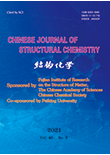Two Low-temperature Phase Transition Compounds Based on Quinuclidine Derivatives with Fluorescence
LI Jun-Yi, CHEN Xiang, TONG Liang, DENG Si-Yu* and CHEN Li-Zhuang*
Chin. J. Struct. Chem. 2021, 40, 149-159 DOI: 10.14102/j.cnki.0254-5861.2011-2874
February 15, 2021
quinuclidine derivatives, fluorescent compounds, crystal structure, second harmonic generation (SHG), permittivity properties
ABSTRACT
Two phase transition materials [iPrQ]2MnBr4 (1, iPrQ
= N-isopropyl-quinuclidinium) and [iPrQ]2MnCl4 (2)
were synthesized and characterized. Dielectric measurements and differential
scanning calorimetry showed that the two compounds underwent reversible phase
transitions at ca. –47 and –37 °C, respectively. Variable-temperature
single-crystal X-ray diffraction suggested that the two compounds underwent the
same phase transitions from space group C2/c to Cc but at different temperature. The variable crystal structures
indicated that the structural phase transitions of the compound were ascribed to
the torsional movement of quinuclidine ring and the disappearance of the c-slide plane. The second
harmonic generation (SHG) response further proved this
structural phase transition. Fluorescence tests showed that the two compounds
have strong fluorescence. The strong variations in dielectric anomalies make
compounds 1 and 2 suitable for promising switchable dielectric
materials.








